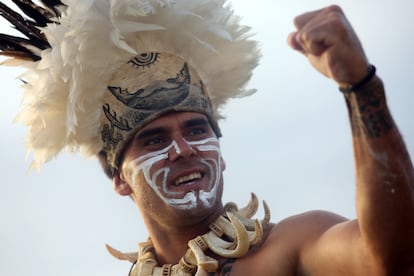I was immersed for a few intense days in the final adventure of Captain James Cook, the great British navigator and explorer (1728-1779). I visited the exhibition at CaixaForum Barcelona Voices of the Pacific where he is mentioned several times, generally for the worse: one work by a Polynesian artist satirizes him and another puts his first ship, the H.M.S. Try to force yourselfwith my head down—, and above all I read an extraordinary book about his third and last fateful journey, The vast seafrom Hampton Sides (Captain Swing, 2025), full of new research. As an appetizer, and worth it, Sides claims that Cook was cooked but not eaten by the Hawaiians after they killed him on the beach at Kealakekua Bay.
Cook, mentioned by Michel Le Bris in his Amoreaux dictionary of explorers (Plon, 2010) underlines how it inaugurated a long fascination which, despite Bougainville and La Pérouse (or Magellan and Álvaro de Saavedra), made the South Seas a space in the Anglo-Saxon imagination (Stevenson, Jack London, The Irish tavern), relives sensationally in the pages of Sides, which dismantles his legend and masterfully retraces the stages of the third journey, of which he visited many places. The American author explains that Cook, already enormously famous after the two previous expeditions, in which he had circumnavigated the world reaching further south than anyone else (with the erroneous conclusion that Antarctica does not exist, no one is perfect), agreed to take command of the HMS Resolution and HMS discovery with the mission this time to find the Northwest Passage, that Arctic Grail that obsessed the English. Along the way, the expedition, which would reach the northern tip of the American continent from the Pacific, through Alaska, and visit icy places and not only the fascinating South Seas (and Tenerife), was supposed to bring home a young Polynesian who had been brought by Cook on the previous voyage.
During the third voyage, the most dramatic and longest, his swan song, Cook went to Hawaii, and it was there that the natives killed the captain in an unfortunate accident. I mistakenly believed that after killing him they had eaten him, at least in part, since the Hawaiians returned a charred piece of thigh, weighing about three kilos, which they will tell me if there is nothing to be suspicious about. In a second delivery arrived other pieces of legs (without feet), part of the skull, fragments of scalp and hands, which had been salted. Sides recalls that unlike other Polynesians, particularly the Maori (who ate ten of Cook’s sailors on his second voyage), native Hawaiians were not traditionally cannibals. “My opinion is, I don’t think it was eaten, but it definitely was cooked,” he explained to me Thursday in an interesting (I would say juicy) telephone conversation from his home in New Mexico. Cook – it is thought what a lovely match he made with Lord Sandwich – was roasted, though not for culinary reasons but as part of a ceremony to remove the flesh attached to the bones, which was where locals believed the spiritual strength of the deceased lay. In reality, Sides points out, what the Hawaiians did was treat Cook as a deceased person relevant to their own culture and converted his remains (the unreturned part) into relics: those of a man considered to be of high status and very powerful.
Sides recalls that to this day the elders of Hawaii, despite the many morbid and grotesque stories that have circulated, have always vehemently insisted that no one should eat any part of Cook’s body and that the captain’s remains should receive treatment as dignified and respectful as that reserved for great chiefs. Naturally the bones circulated widely around the island.
Sides was unable to give me information on the alleged arrow made from a piece of Cook’s tibia that Tony Horwitz talks about in his splendid blue latitudes (RBA, 2004) and having tracked him down in an Australian museum (taking the opportunity to reflect on the possibility of cloning the captain). Sides, by the way, met with Horwitz and told me the sad news that the Pulitzer-winning writer died in 2019 of a heart attack.
Regarding what happened on the beach in Hawaii that fateful day of Cook’s death, Sides states that the captain lost his composure and “did not act with the diplomacy of the past.” The Hawaiians, who had a different concept of private property than the Europeans, had stolen a boat from the expedition and Cook seemed to go mad: he went in search of King Kalaniopu’u and took him hostage to force him to return what was stolen. “He was unreasonable and did not read the situation properly, there was a violent escalation and the warriors protecting the monarch attacked the captain and his men as they tried to return to the ships.” Cook, who had fired his pistol and killed one warrior, was hit in the head by another with a club (there are some very telling ones in the CaixaForum exhibition) and, when he fell, a third stabbed him in the neck with a club. pahoaa traditional dagger that often featured shark teeth or a swordfish beak, and continued to stab him brutally. Then they smashed his skull with a stone. It is curious that Cook ended up similarly to Magellan.
Sides believes the experienced chef developed overconfidence and believed he could handle any situation well. “He committed a sin of arrogance as the Greeks would say.” It is possible that Cook also suffered from some mental illness or disorder, he adds. He seems no longer to be the same as on his other voyages and there is evidence that he became more severe and even cruel, having the whip used, an unusual punishment for him, with a frequency worthy of Captain Bligh of Rebellion on board (by the way, Bligh, who years later would command HMS generositywas part of Cook’s third expedition, as was another future star, George Vancouver). “We will never know what happened to Cook, it was speculated that the physical damage of so much travel was taking its toll on him, he seemed exhausted.” Hampton Sides cannot escape the joke that Cook, who had been to the extreme latitudes of the North and South, crossing both the Antarctic and Arctic Circles, was obviously bipolar.
He points out that Cook is currently quite frowned upon in Hawaii and other places in the South Seas, where he is attacked as a symbol of colonialism and as a figure whose arrival marked the “fatal impact,” the beginning of the destruction of traditional cultures: a “Christopher Columbus of the Pacific.” Sides’ opinion is different: “You can denigrate him, but he is undoubtedly one of the greatest captains and navigators of all time. In reality, what came after must be attributed to him. Cook, a self-made man, austere, fair, sincere, was above all an explorer, his interest was in knowing the world and drawing maps, in which he was a true genius. to the point that one can say that his vision is that of a proto-anthropologist. He showed no prejudices, he did not moralizing and never tried to convert the natives. True that the victim had already been killed when Cook arrived at the lively ceremony, but he saw how a chief ate the left eye of the sacrificed man.
It is curious that there is no memorable film about Cook. “Yes, it’s strange, because his adventures are very cinematic.” Side really liked it Master and Commanderthe adaptation of Patrick O’Brian’s novels whose protagonists, Aubrey and Maturin, somehow reproduce the relationship between Cook and the naturalist of his first voyage, Joseph Banks, of whom Sides, among other things, does not have a very good opinion.

In The vast sea There’s enough sex, which makes you think The island of the three mermaidsby Irving Wallace. “In many places in the Pacific, such as Tahiti, European sailors could openly have sexual relations with unrepentant local women,” the author notes. It seemed like paradise to them; even more so for the control of the body that the local inhabitants had, whose ability to move their hips by giving them a rotational movement was praised. Polynesian women, on the other hand, found kissing disgusting. “There has been much discussion about what drove them to these unions. Partly curiosity, breaking of taboos and a genuine desire for different, mostly very young men. Perhaps there was a natural impulse to escape the endogamy of the islands, and gifts would also have played a role. It seems that there were sincere romantic relationships. The dark side was the massive spread of venereal diseases by Europeans.”
Would we have liked Cook? Probably not too much. Hampton Sides points out that he was “a sailing machine” (though curiously he couldn’t swim), circumspect and unromantic. He valued precision and had no social skills. He had started in the Royal Navy from the bottom, as a private sailor, and as a captain he took care of his men. He could eat anything and felt at home in the Pacific. His great nightmare was that his sextant would be stolen. He appears to have practiced strict chastity despite the erotic atmosphere of Polynesia. Perhaps this had something to do with the bad temper of his last days.



